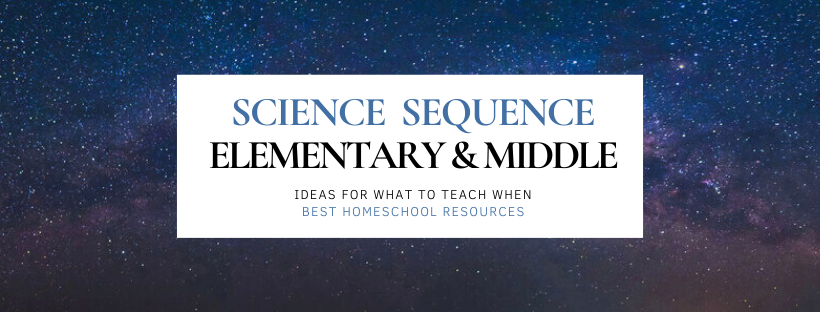On this page: General Resources | Tips | How-To
science pages
General Resources
📃 Science Sequence from Best Homeschool Resources. Wondering what to teach and when? Download the BHR Science Sequence (PDF) to find specific topic ideas across the four core subjects–Life Science, Earth & Space, Chemistry, and Physics–at the Elementary and Middle School levels. – Elementary • Middle
📃 Elementary Lab-Based Physical Science from Best Homeschool Resources. For a hands-on approach to homeschool science, check out our new Lab-Based Guide to Physical Science (PDF). This free, flexible guide is divided into six units and corresponds to a year-long integrated Physical Science study of topics across Chemistry and Physics. – Elementary
tips
The resources are organized into four core subjects: Life Science, Earth & Space, Physics, and Chemistry. Each home page links out to a collection of topic pages. Check out the home pages to find general resources and subject-specific textbooks.
Don’t try to do everything. These pages are full of amazing resources. However, you don’t need to read every book, watch every video, and do every experiment. Sometimes it’s enough to read one picture book, watch a short video, and move on. Other times, your child will become absorbed in a topic, and you will want to slow down and explore more deeply. Let your child’s age and interests be your guide.
Build unit studies. Follow the “Connection” links on the science topic pages to build rich, multi-disciplinary unit studies.
Don’t confine yourself to grade-level designations. The resources are broadly delineated by grade level (Preschool, Elementary, Middle, and High). However, if your Elementary School child discovers a passion for a certain subject, consult the Middle School resources for ideas on ways to extend your study. Likewise, if your Middle School child has never encountered a subject before, browse the Elementary School resources for ideas on how to cover the basics.
how-to
The Science Sequence and Resource pages can be used together to provide a rich and enjoyable homeschool science education without a curriculum. How can this approach work in practice? Here are two examples that illustrate how the Sequence and Resource pages can be used at the Elementary or Middle School levels.
Insects
An Elementary School Unit Study
Getting Started
Your third-grader is fascinated with insects. You consult the Science Sequence for topic ideas and decide to start by learning some general facts about insects: What do they look like? How do we classify them? How do they reproduce? How are our lives affected by the insects around us?
You browse the Insects page and find some resources to get you started. Together, you and your child read a few picture books and watch several videos that help you answer these questions. You get an insect guide and head out for nature walks to see how many different insects you can find.
Following Interests
Your child would like to learn more about his favorite insect – the butterfly. Using recommendations from the Insects page, you and your child read a stack of picture books about butterflies and watch a video about butterfly metamorphosis. This video inspires a desire to witness metamorphosis in action, so you get a butterfly garden and closely observe as your caterpillars turn into beautiful butterflies.
Moving On
You would be happy to keep studying different kinds insects for a few more weeks, but your child has other ideas and is asking to ditch the bugs and learn a little about Birds. You wrap up your unit on insects and dive into the next topic, secure in the knowledge that you have given your child a memorable and enjoyable introduction to insects and that you will be revisiting this topic in more depth in the years ahead.
Keeping Track
If your child likes to draw, he may enjoy keeping a nature journal to record his observations. If he likes to write, he might want to put together a brief report on one of the topics that he has studied. If he likes to talk, you and other family members can engage him in conversations about what he has learned. For your own records, keep track of all the activities, books, and videos that you used in this study.
Astronomy
A Middle School Unit Study
Getting Started
You are following a 4-year science cycle with your middle schooler and are studying Earth & Space this year. You’ve just finished learning about the Earth and are now ready to explore the Universe. You’re loosely using an online textbook as a spine for the year, but upon consulting the Science Sequence for specific topic ideas, you decide to start the unit with a study of the life cycles of stars.
Using recommendations from the Universe page, you and your child read a few books and watch several videos about stars, constellations, and galaxies. On a clear evening, you take out your telescope and star guide to observe the stars in the night sky.
Following Interests
Your child becomes particularly fascinated with how Black Holes form from massive dying stars. From the Universe page, she finds a book about Black Holes and a bunch of videos on this topic.
This exploration leads to an interest in gravity, so you follow a cross-link to the Solar System page, where your child has fun exploring the online gravity simulation. Learning about gravity leads to questions about the origins of the universe, so you turn to the Big Bang section of the Universe page to learn more.
Moving On
At this point, you are ready to move on, but your child has developed an obsession with astronomy and is hungry for more information. You point her to the more advanced astronomy video series listed on the Earth & Space Home page and set about finding a Citizen Science project—like searching online NASA data for comets—that she can contribute to.
Keeping Track
Before you wrap up this unit, you might invite your child to prepare a formal report or presentation on Black Holes or another area of interest. Or you might find that frequent informal discussions—and her obvious enthusiasm for the subject—serve as sufficient evidence that your child has internalized the material. For your own records, keep track of all the activities, books, and videos that you used in this study.









